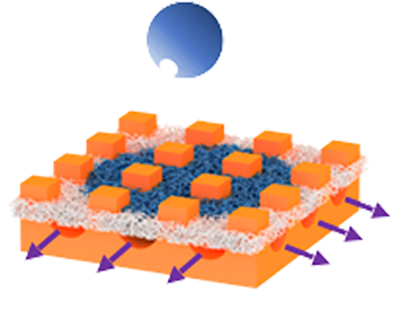The Leidenfrost effect is one of those physical phenomena that can be observed directly at home: drops of cold water falling on a hot pan that roll on it without evaporating. Beyond its entertaining aspect, this effect is also responsible for crucial problems, especially when a surface must be strongly cooled. French and Chinese researchers including the PMMH laboratory have developed a textured coating that avoids this effect up to at least 1100 °C. Their work has just been published in the journal Nature.
 Credits : Mengnan Jiang, David Quéré et Zuankai Wang
Credits : Mengnan Jiang, David Quéré et Zuankai Wang
The Leidenfrost effect is a formidable enemy when it comes to the rapid cooling of very hot metals or to avoid out of control temperature increases (e.g. in nuclear power plants). In practice, when water droplets are used to refrigerate a hot surface, part of the water will evaporate and create an insulating thermal barrier, which prevents heat exchange between water and material to be cooled. As a result, the temperature of the surface then increases uncontrollably if there is a source of heat close to it.
In the last 10 years, researchers have been devising solutions, often linked to surface texturing, to push back this phenomenon as much as possible. In the PMMH laboratory, David Quéré has worked on different variations around the Leidenfrost effect, as well as on structuring materials to modify their properties, for instance to make them super-hydrophobic. With his Chinese colleagues from the University of Hong Kong, the scientist has developed a flexible textured surface combining a forest of pillars with an insulating mesh under which channels allow the steam to escape.
The Leidenfrost effect, which commonly sets around 200°C, had been pushed back to 500°C by texture effects. But here, the researchers have managed to raise this temperature above 1100°C – a giant shift by 600°C! The key point lies in the combination of structures: on the one hand, the insulating mesh absorbs the droplets, which maintains the contact between the solid and the liquid; on the other hand, evaporation is massive at high temperature, but the underlying channels evacuate steam without it can lift the liquid.
This achievement in spray cooling will allow the researchers to improve their material, for example by optimizing the pore size in the mesh. In addition, the material was made flexible in order to use it on a wide variety of surfaces, including pipes and other heat exchangers.
Reference: Jiang, M., Wang, Y., Liu, F. et al. Inhibiting the Leidenfrost effect above 1,000 °C for sustained thermal cooling. Nature 601, 568–572 (2022). https://doi.org/10.1038/s41586-021-04307-3
See also: News and Views of James C. Bird : https://www.nature.com/articles/d41586-022-00123-5
contact: David Quéré david.quere@espci.psl.eu







